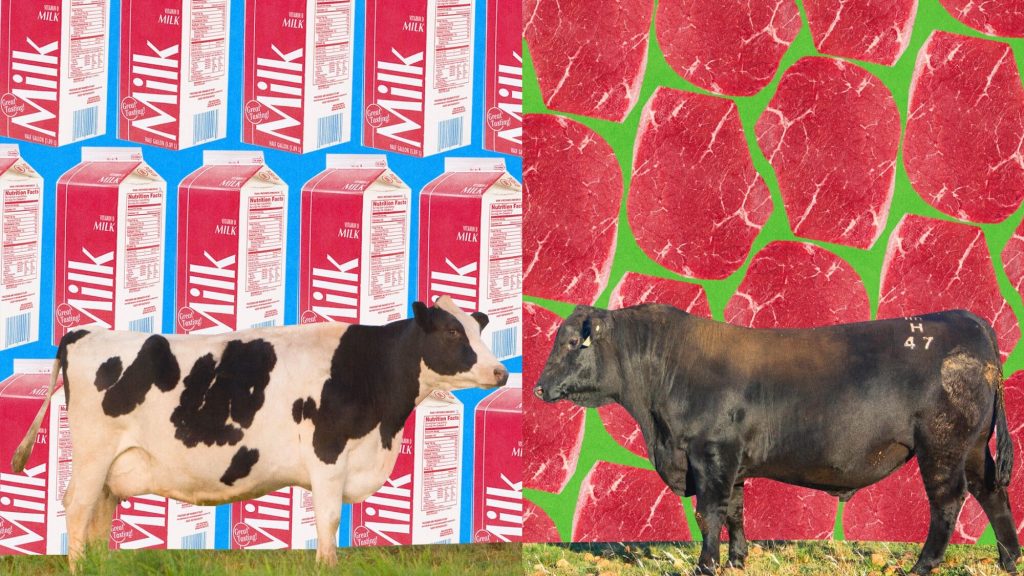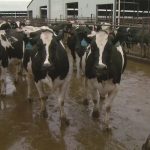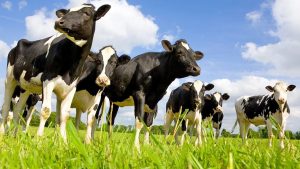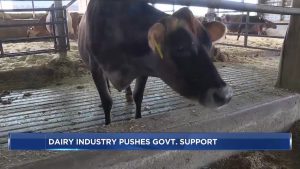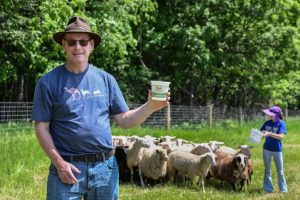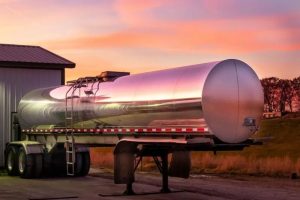
The additional income stream is a welcome boost for US dairy producers, who’ve had a tough couple of years selling milk.
With America’s supply of beef cattle the lowest since 1961, dairy farmers are finding another way to make money: breed more calves destined for the slaughterhouse.
Dairy farmers, who traditionally produce new milking cows to replace their outgoing ones, are increasingly churning out meatier offspring that they can sell to ranchers to raise for human consumption. Those hybrid calves — created by artificially inseminating a dairy cow with semen from a beef bull — are beefier than a pure dairy animal and can fetch the seller hundreds or even thousands of dollars apiece. That’s a big payday in an industry that last summer faced such a pronounced milk glut that farmers were forced to dump it down the drain.

“Milk prices are up and down and so farmers are always looking for a way to offset costs to be as efficient as possible,” said Amy Penterman, an owner of Dutch Dairy LLC in Wisconsin, which breeds about 70% of its 900-cow milking herd for beef. In addition to capturing new revenue, “it’s also rewarding because the beef supply has diminished over the last few years. We’re able to add that extra supply into the market to keep the cost down for our consumers.”
The shrinking supply of cattle follows years of ranchers culling more animals than they were retaining for breeding because of persistent droughts, surging feed costs and high interest rates. The beef herd is at its smallest since President John F. Kennedy’s first year in office, with commercial beef production forecast to fall even further next year to the lowest in a decade.
Given the depleted beef supply, a week-old hybrid calf can now fetch between $400 to $800, up from $200 a few years ago, Penterman said. Farmers who raise the calves to adulthood can charge even more. Krent Frauhiger, a dairy manager in Indiana, rears the so-called “beef-on-dairy calves” for around 16 months until they are about 1,400 pounds. Those livestock can fetch about $2,500 each, nearing what farmers receive for an actual beef animal, he said. That’s far more profitable than raising replacement milking cows, which CoBank estimates in recent years actually lost farmers as much as $900 a heifer.

The diversified income stream is a welcome addition for America’s dairy producers, who struggled when demand — and in turn, prices — fell at the start of the pandemic. Although anxious shoppers were clearing out the milk aisle at grocery stores, that didn’t offset the drop in demand from closed restaurants and schools. Farmers had so much excess that they poured milk down the drain, a supply-management tool they’ve had to use again more recently.
The breakdown in the supply chain only added to the woes of the US dairy sector, which even before Covid-19 suffered a wave of closures and consolidations following years of low milk prices. The number of dairy farms in the US plummeted about 39% from 2017 to 2022, according to the government’s most recent agricultural census.
As the dairy industry teeters, demand for red meat remains strong. US consumers eat close to 60 pounds of beef a year. Milk and cheese prices are virtually unchanged from a decade ago, US Department of Agriculture data show, while ground beef prices have climbed more than 35%, touching a record high in November.
Beef Prices Climb While Dairy Gains Stagnate
Change in US prices in the last 10 years
Beef prices have “just exploded and it’s been fuel on a fire,” said Steve Obert, the executive director of Indiana Dairy Producers.
That allows them to produce close to the exact number of replacement dairy heifers they need, then breed the rest of their herd for beef-on-dairy calves. Nearly 85% of the 9.4 million units of beef semen sold in the US in 2023 went to dairy farms, according to the National Association of Animal Breeders.
Beef Semen Sales Rise on Demand From Dairy Farmers
Domestic dairy and beef semen sales
The hybrid calves produced through the targeting breeding yield more meat than traditional dairy cattle, whose bodies are more focused on making milk than muscle, though less than one bred for beef. An average 1,200-pound beef animal would yield about 450 pounds of boneless steaks, roasts and ground beef, nearly 14% more than a Holstein dairy cow, according to South Dakota State University researchers.
Beef-on-dairy crosses likely “trend closer to the beef numbers as many crosses have adopted a stronger beef body type than dairy,” said Christina Bakker, an assistant professor and meat science extension specialist at the university. Some even say the crossed calves produce better quality meat, given dairy cattle’s ability to deposit marbling.
There were 2.7 million beef-on-dairy calves born in 2022, more than 12 times the number born in 2016, according to research firm CattleFax. Beef-on-dairy cattle made up 10% of the fed slaughter market in 2022, and that share is expected to rise to 15% by 2026, the firm estimates.

Refocusing a dairy farm’s breeding program toward beef-on-dairy hybrids is not without its risks. Tip too far in the beef direction and there won’t be sufficient supply to sustain milking herds. The pendulum may have already shifted: The number of available replacement cows for dairy herds in January 2024 was the lowest for that time of year in two decades. Last marketing year, the average price for a milk cow rose to $1,760, the highest in seven years, according to the USDA.
If milk prices rise, low inventories and higher prices for replacement cows could limit the expansion of dairy production and make it hard for farmers to grow profits, said Lucas Fuess, a senior dairy analyst at Rabobank. The number of replacement heifers is already “down to the minimum level” needed to maintain the dairy herd, said Nate Donnay, the director of dairy market insight at StoneX Financial.
Milk Cow Replacement Inventory Shrinks
Number of available dairy replacement heifers
“Ten years from now, the beef herd’s probably going to get too big again and prices will be terrible and maybe they don’t want these dairy animals anymore,” Donnay said. “But for the next couple of years, that demand for dairy animals into the beef herd is probably going to stay strong.”

Austin Allred, the owner of Royal Family Farming in Washington state, has seen the benefits of the beef-on-dairy trend first hand. Because of the new developments, he has been able to select his best cows to produce offspring to stay in the milking herds. Those animals are healthier and can yield more milk for longer, so fewer cows need to be replaced each year to sustain the same level of production, he said. Cows that make less milk are then bred for beef-on-dairy animals, which are optimized to grow quickly and have favorable qualities like good marbling, said Allred, whose farm milks 6,000 cows every day.
“Farmers are obsessed with genetics,” he said, “and will forever be obsessed with good, productive, efficient animals.”
You can now read the most important #news on #eDairyNews #Whatsapp channels!!!
🇺🇸 eDairy News INGLÊS: https://whatsapp.com/channel/0029VaKsjzGDTkJyIN6hcP1K
